Create Baremetal Site
On This Page:
Objective
This document provides instructions on how to create an F5® Distributed Cloud Services single-node or multi-node site on custom hardware, with a site software image file. For more information, see F5 Distributed Cloud Site.
Prerequisites
-
A Distributed Cloud Services Account. If you do not have an account, see Create an Account.
-
A Distributed Cloud Services node software image file. See Images to download the software image file.
-
Resources required per node:
- Minimum 4 vCPUs and 14 GB RAM.
- 45 GB is the minimum amount required for storage. However, if you are deploying an F5® Distributed Cloud App Stack Site, F5 recommends 100 GB for storage.
-
Internet Control Message Protocol (ICMP) needs to be opened between the CE nodes on the Site Local Outside (SLO) interfaces. This is needed to ensure intra-cluster communication checks.
-
Internet Control Message Protocol (ICMP) needs to be opened between the CE nodes on the Site Local Outside (SLO) interfaces. This is needed to ensure intra-cluster communication checks.
By proceeding with the installation, download and/or access and use, as applicable, of the Distributed Cloud Services software, and/or Distributed Cloud Services platform, you acknowledge that you have read, understand, and agree to be bound by this agreement.
Restrictions
The USB allowlist is enabled by default. If you change a USB device, such as a keyboard after registration, the device will not function.
Minimum Hardware Requirements
The Distributed Cloud Services Node software is designed to work on most commodity hardware.
Use the following minimum requirements to help you choose your commodity hardware for Distributed Cloud Services Node deployments:
| Memory | Networking | USB | HDMI | Disk Space |
|---|---|---|---|---|
| Minimum: 14 GB | Minimum: 1x 1000Mb/s (Intel-based) | Minimum: 1 USB 2.0/3.0 for Imaging the host | Minimum: 1 HDMI for imaging the system. Only required if the hardware provided is not Distributed Cloud Services packaged. | Minimum: 64 GB |
| Recommended: 16 GB | Distributed Cloud Services provides multiple network interface controller (NIC) support. You can use multiple NICs for a Customer Edge site. | Varies with peripheral connections (camera, etc.) | Recommended: 128 GB |
As you plan for your hardware setup, consider the following information:
- Current architecture supported is x86. Arm is currently on the roadmap.
- Memory, storage, and CPU requirements vary based on application usage on the system/host.
- Data Plane Development Kit (DPDK) support is a mandatory requirement. Refer to Intel DPDK for more information.
- USB requirements for the host vary on the number of peripheral device connections.
Supported Hardware
-
All the hardware listed below has been tested and supported by Distributed Cloud Services. Known caveats are listed in the respective sections.
-
Distributed Cloud Services nodes can only be deployed on hardware with Intel-based Ethernet cards with DPDK support. See Intel DPDK.
-
Refer to product-specific data sheets for more information.
-
Using the minimum hardware requirements listed above, you may attempt to install a Distributed Cloud Services Node, but official support is limited.
Note: The Distributed Cloud Services Node software is certified to run on the hardware specified in the following sections. If you want to certify Distributed Cloud Services Node software for your specific hardware setup, email
sales@cloud.f5.com.
Edge Hardware
| Vendor | Model | Processor | Memory | Networking | Storage | USB | HDMI | Graphics | Input Voltage |
|---|---|---|---|---|---|---|---|---|---|
| Intel | NUC7i7DNKE | 1.9 GHz Intel Core i7-8650U quad-core processor | 32 GB DDR4 SO-DIMM RAM 2400 MHz | 1x Intel 10/100/1000 Gigabit Ethernet | 1 TB SSD SATA III | 4x USB 3.0 | 2x HDMI 2.0 | Dual HDMI 2.0a, 4-lane eDP 1.4 | 12-24 VDC |
| Intel | NUC8i3BEH | Intel® Core™ i3-8109U Processor (4M Cache, up to 3.60 GHz) | 32 GB DDR4-2400 1.2V SO-DIMM | 1x Intel 10/100/1000 Gigabit Ethernet | 1 TB M.2 SSD SATA | 5x USB 3.1 Gen 2 3x USB 2.0 | 1x HDMI 2.0a | Intel Iris™ Plus Graphics 655 or Intel UHD Graphics 620 | 12-19 V DC |
| Fitlet2 | E3950 | Intel Atom™ Processor x7 Series E3950 1.6GHz to 2GHz | 1x SO-DIMM 204-pin DDR3L Non-ECC DDR3L-1866 (1.35V) Up to 16GB | 2x GbE LAN ports (RJ-45), LAN1: Intel I211 GbE controller, LAN2: Intel I211 GbE controller | 1x M.2 M-Key 2242/2260* on board *M.2 2280 optional on some facet cards | 2x USB 3.0 and 2x USB 2.0 | HDMI 1.4 3840x2160 @30Hz | Intel® HD Graphics 505 Dual display mode supported | Unregulated 7 – 20VDC* input |
Note: Fitlet2 interface naming is reversed. Eth2 = eth0 (WAN/Site Local Interface) and Eth1 = (LAN/Site Local Inside Interface).
Server Hardware
| Vendor | Model | Processor | Memory | Networking | Storage | USB | RAID | HDD | Input Voltage |
|---|---|---|---|---|---|---|---|---|---|
| Kingstar | SYS-1029U-TN10RT | Intel Xeon | DDR4-2666 32GB x 12 (384GB+) | Intel XXV710 (10/25G) | SSD NVMe (1TB, 4TB) | ||||
| Dell | PowerEdge R640 | Intel Xeon Gold 6230N(20 Core/2.3GHZ/27.5MB Cache/HT)x2 | 384GB:32GB*12 - DIMM | Intel X710 10G SFP + x2 Port + Intel i350 1G Base-T x2 Port Add-on: Intel X710 10G SFP+x2 Port PCIe NIC x1 or Intel XL710 40G QSFP+ x2 Port PCIe NIC x2 | 960GB (mixed use SDD/Dell AG Drive) x3 (6GBPS SATA/2.5inch/HotPlug) | 2 x USB 3.0 | PERC H740P SAS RAID controller | 960GB (mixed use SSD/Dell AG Drive) x3 (6Gbps SATA/2.5inch/HotPlug) | 1100W 48VDC |
| Dell | PowerEdge R650xs | Intel Xeon Gold 6336Y (24Core/2.4GHz/36MB Cache/HT) | 384GB(12 x 32GB DDR4 RDIMM,3200MT/s, Dual Rank) | Intel E810-XXV Quad Port 10/25GbE SFP28 OCP NIC 3.0; | 960GB SSD SATA Read Intensive 6Gbps 512 2.5 inches Hot-Plug AG Drive, 1 DWPD x3 | 1 x iDRAC Direct (Micro-AB USB) 2 x USB 2.0 1 x USB 3.0 | PERC H755 SAS | 960GB SSD SATA Read Intensive 6Gbps 512 2.5 inches Hot-Plug AG Drive, 1 DWPD x3 | 800W, 100-240VAC/240VDC |
| Dell | PowerEdge R660 | Intel Xeon Silver 4416+(20Core/2.0GHz/37.5MB Cache/HT) | 768GB(12 x 64GB DDR5 RDIMM,4800MT/s, Dual Rank) | Intel X710-T4L Quad Port 10GbE BASE-T, OCP NIC 3.0; Intel X710-T2L Dual Port 10GbE BASE-T Adaptor, Low Profile PCIe | 960GB SSD SATA Read Intensive 6Gbps 512 2.5 inches Hot-Plug AG Drive, 1 DWPD x4 | 1 x iDRAC Direct (Micro-AB USB) 2 x USB 2.0 1 x USB 3.0 | PERC H965i, PERC H755, PERC H755N, PERC H355, HBA355i, PERC H965e | 960GB SSD SATA Read Intensive 6Gbps 512 2.5 inches Hot-Plug AG Drive, 1 DWPD x4 | 1100W |
| HP | ProLiant DL360 Gen10 8SFF NC | Intel Xeon Gold 6222V (20 Core, 1.8GHZ, 27.5MB Cache) x 2 | 32GB x 12 (384GB) DIMM | 2x HPE Ethernet 10/25Gb 2-port SFP28 interfaces (Mellanox MCX4121A ConnectX-4 Lx), 1x HP Ethernet 1Gb 4-port 366T Adapter (Intel) | 2 x USB 3.0 | PERC H740P SAS RAID controller | 800W |
Create Site
Before you deploy a single-node or multi-node site on baremetal, you must create a site in the F5 Distributed Cloud Console. For information, see one of the following documents:
-
To create a Secure Mesh Customer Edge, see Create Secure Mesh Site.
-
To create a AppStack Customer Edge, see Create App Stack Site.
Prepare a Bootable USB
To create a bootable USB drive, you must flash the Distributed Cloud Services CE ISO image onto a USB drive. Depending on your operating system, you can use software, such as Etcher to quickly flash the USB drive with the ISO image.
Step 1: Download Etcher software based on your operating system.
-
Navigate to Etcher to download the installer file.
-
Follow the instructions to install Etcher.
Note: If you are running macOS X Catalina, you need to download the latest version of Etcher. If you do not and attempt to flash an ISO image, this terminal message appears:
“balenaEtcher” can’t be opened because Apple cannot check it for malicious software
Step 2: Download the Distributed Cloud Services Node ISO image file.
Navigate to Certified Hardware and KVM Images to download the file. A certified Distributed Cloud Services Node image software (.iso/.img) is packaged with all the required components to provision Distributed Cloud Services-based components.
For more information on choosing an appropriate image for your certified hardware, see How to choose an image for your site deployment?.
Step 3: Flash the USB drive.
-
Insert a USB into your computer.
-
Open Etcher.

- Follow the instructions to begin the flash process.
Important: You can also utilities such as VirtualCD with iDRAC, iLO and so on to boot the Distributed Cloud ISO. For instructions, see the documentation for the utility to want to use.
Configure the BIOS
Prior to installing the Distributed Cloud Services Node software, you need to configure your system’s BIOS menu. The BIOS provides the basic functions needed to boot your system and enables you to access specific hardware components.
Step 1: Invoke the BIOS menu.
To enter the BIOS menu, press a key or key combination (Delete or the F2 key) immediately after turning on your computer.
Note: The key combination differs from manufacturer to manufacturer. Typically, the start screen on the computer displays a message, stating which key to press to enter the BIOS menu.
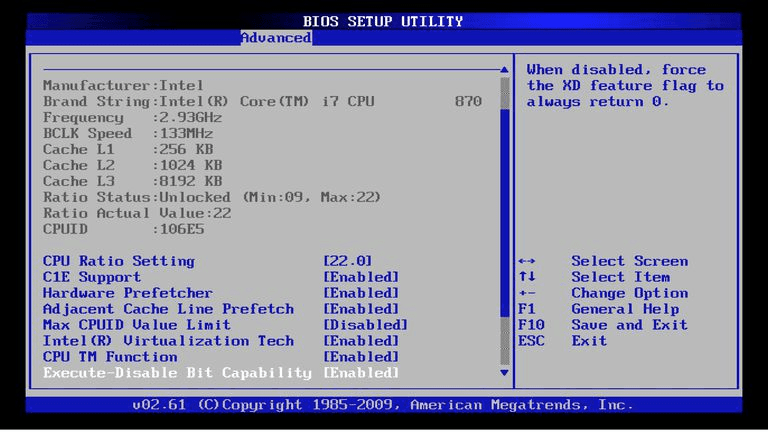
Step 2: Select boot device.
Within the BIOS setup menu, you can select which devices will check in which sequence for a bootable operating system in the Boot tab.
Note: The possible choices usually include the internal hard disks, the CD/DVD-ROM drive and mass storage devices, such as USB sticks or external hard disks. The installation media in most of the scenarios is a flashed USB drive with the Distributed Cloud Services Node image.
- Select the USB drive to boot first from the boot menu options.
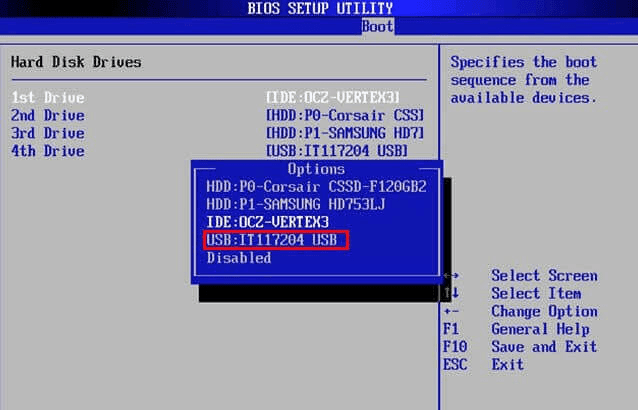
Most BIOS versions allow you to call up a boot menu on system startup in which you select from which device the computer starts for the current session. If this option is available, the BIOS usually displays a short message like “press F12 for boot menu” on system startup. The actual key used to select this menu varies from system to system. Commonly used keys are F12, F11, or F8. Choosing a device from this menu does not change the default boot order of the BIOS. In other words, you can start once from a USB drive while having configured the internal hard disk as the primary boot device.

Step 3: Check and fix potential issues.
If you have no PS/2-style keyboard, but only a USB model, you may need to enable legacy keyboard emulation in your BIOS menu to use your keyboard in the bootloader menu. Modern systems do not have this issue.
If your keyboard does not work in the bootloader menu, consult your system manual and look in the BIOS for “Legacy keyboard emulation” or “USB keyboard support” options.
Install the Node OS Software
After the boot order is configured to USB, a prompt loads with information to install the Distributed Cloud Services node OS.
- Use the keyboard arrows to select
Test this media 9 install RHEL 9. This is the recommended option.

- After the boot process completes, select your preferred language settings. Then click
Continue.
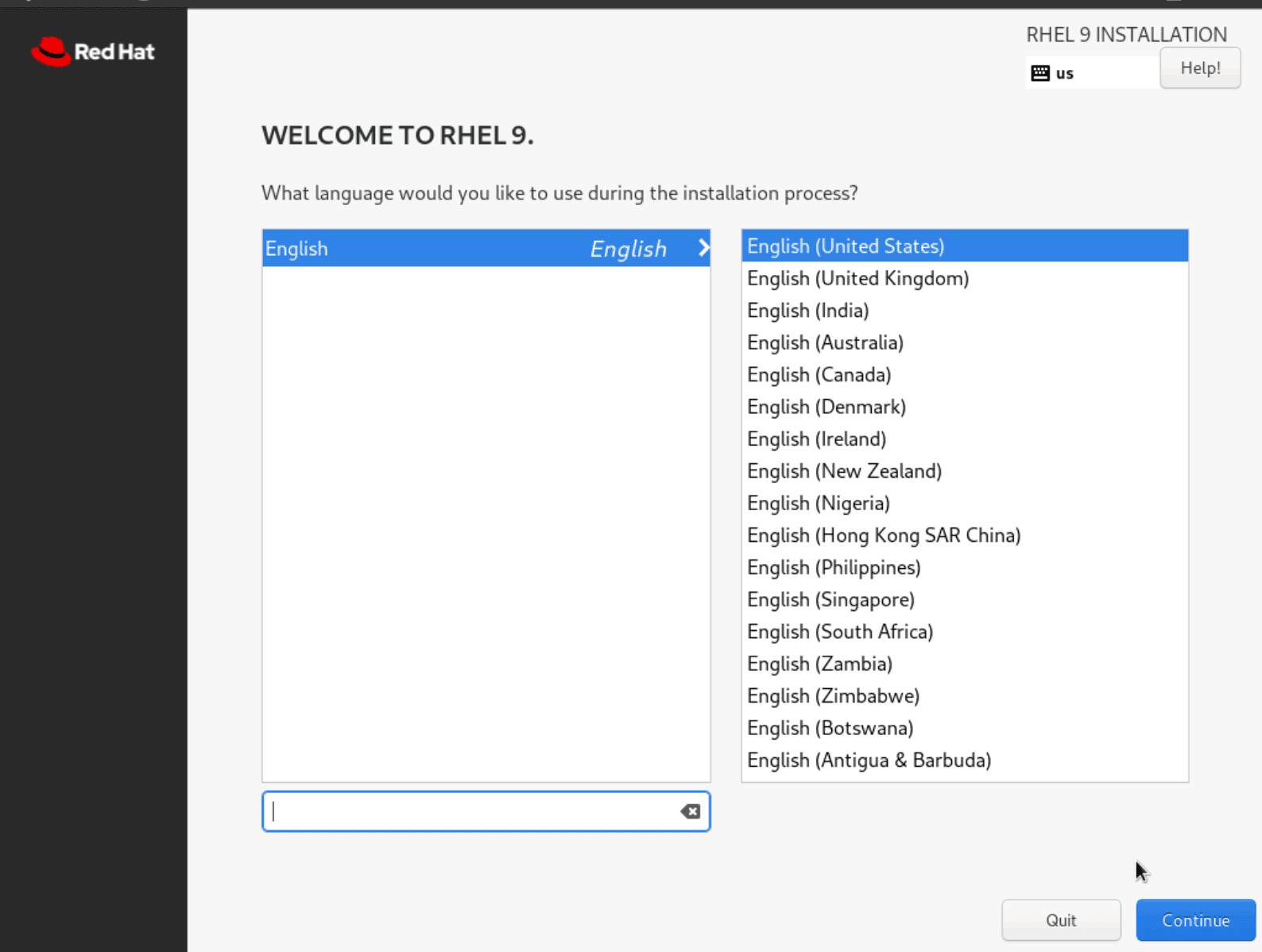
- Select
Installation Destination.
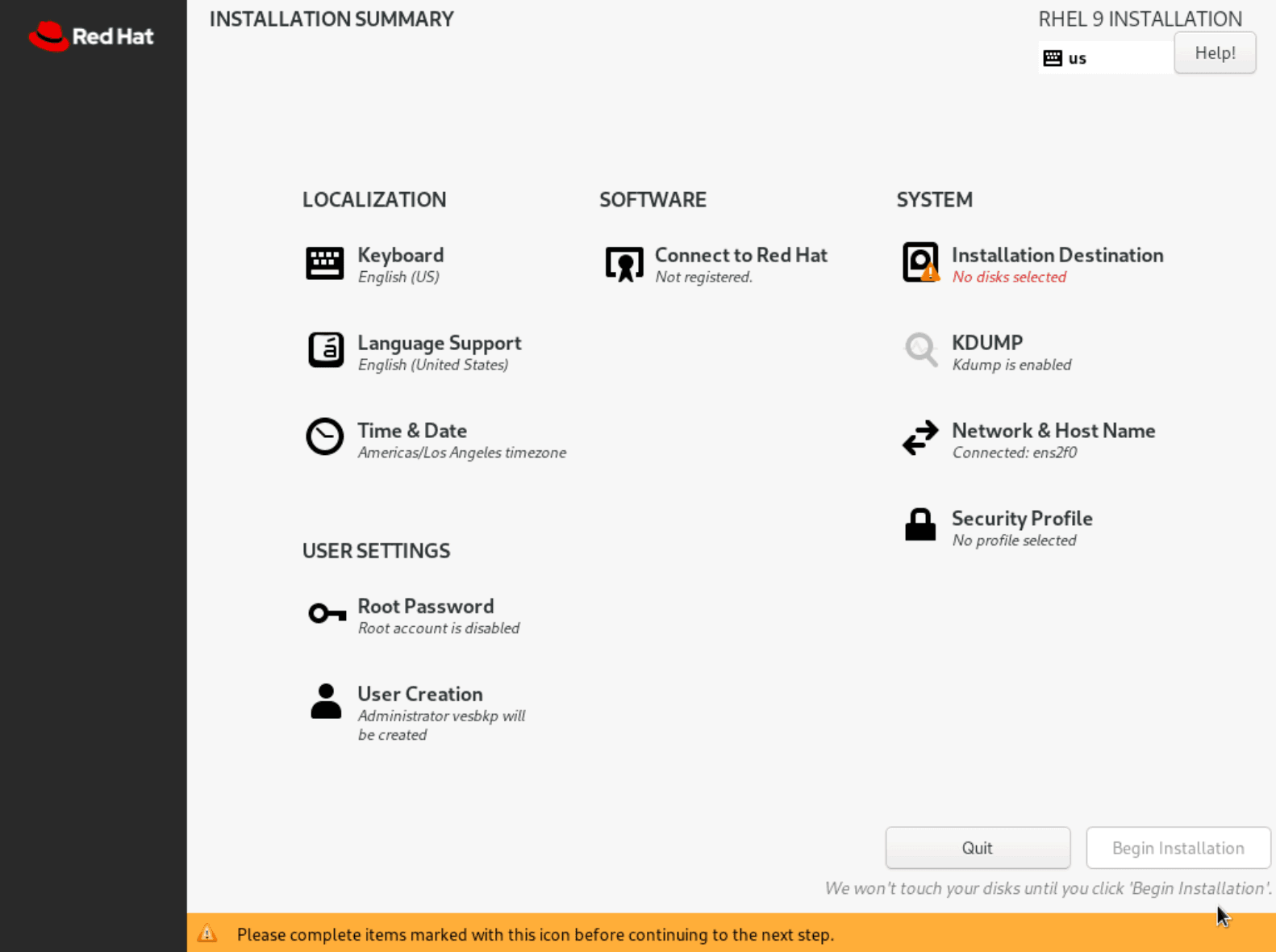
- Select the disk to set as the installation destination, configure any additional settings, and then click
Done.
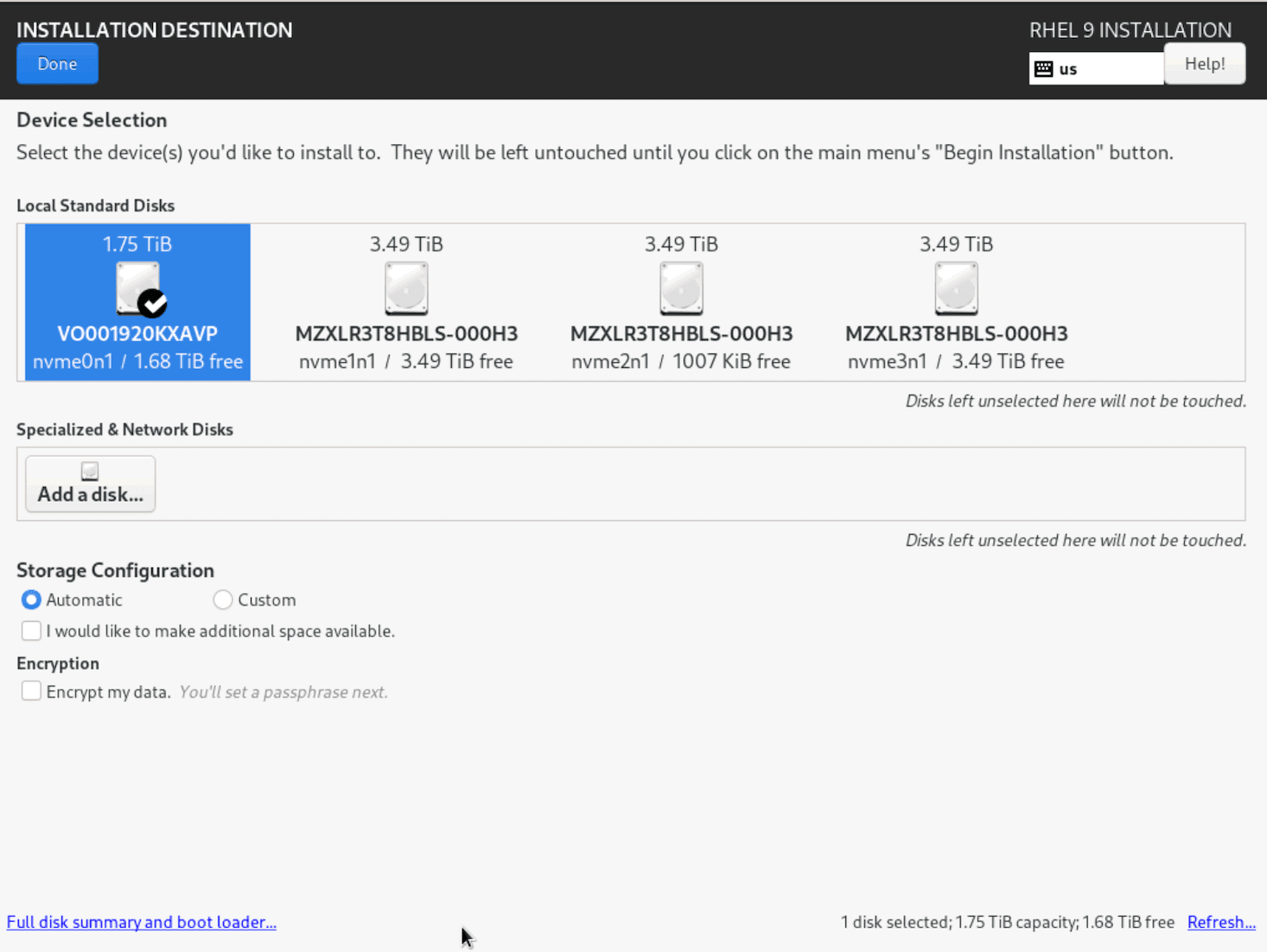
- On the
INSTALLATION SUMMARYpage, clickBegin Installation.
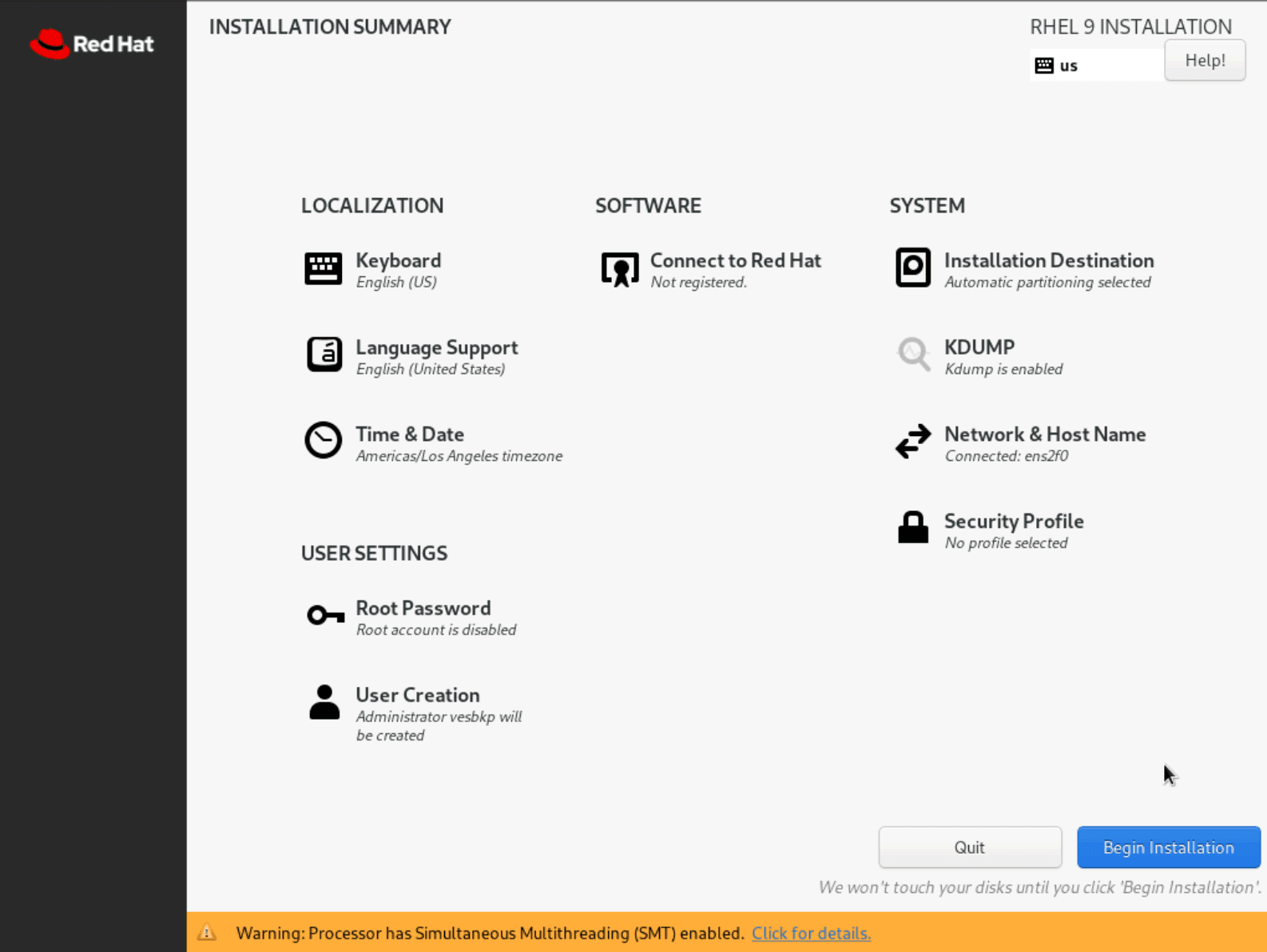
- After the installation process completes, click
Reboot System.
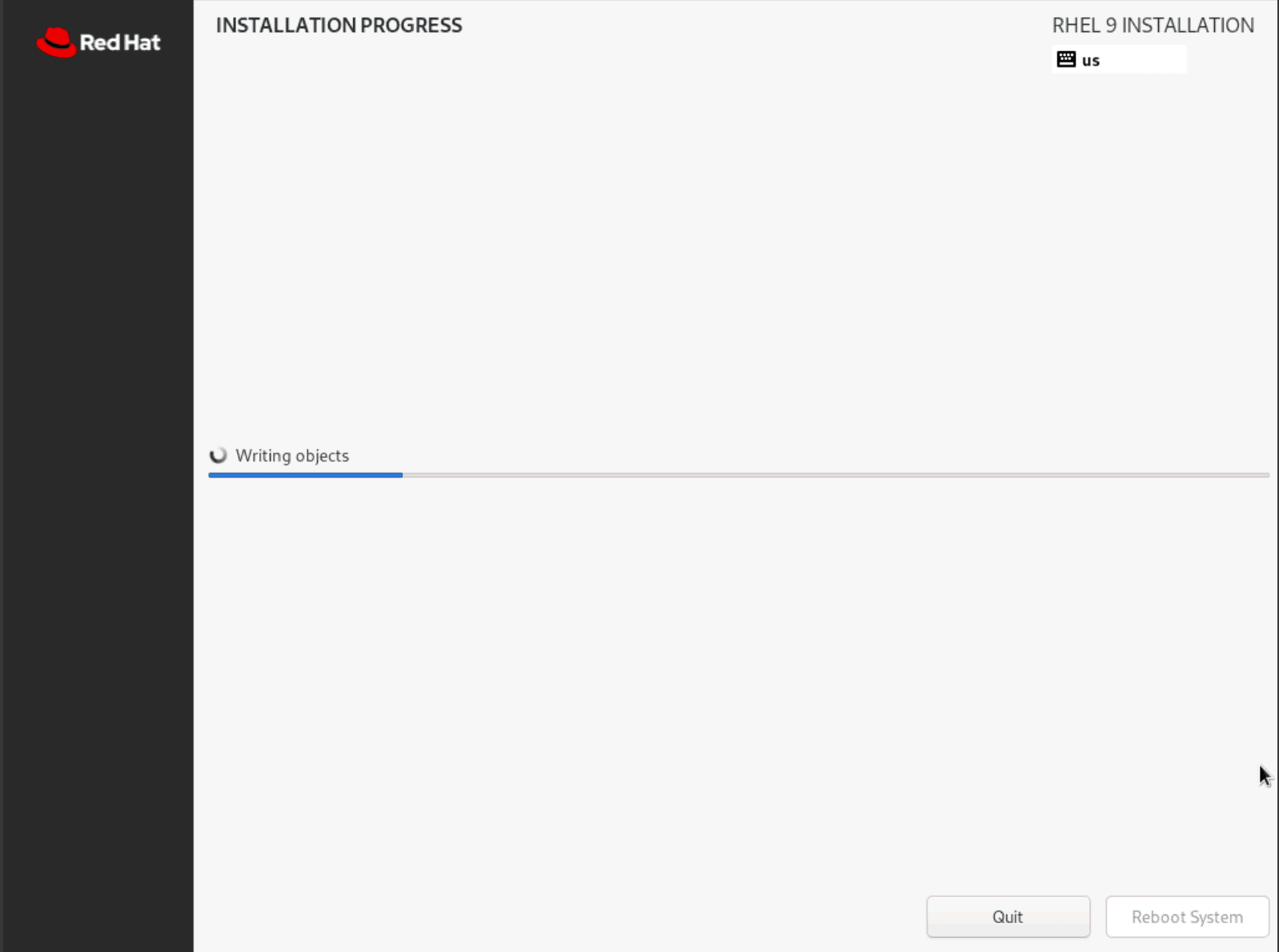
Post-Install Node Parameter Configuration
Log in to the node to configure additional options.
Step 1: Log in to the node.
-
Access the node using SSH or through a console window.
-
Log in to the node with the default user credentials:
- Local user account:
admin - Password:
Volterra123password.
If this is the first time you are logging in, you are prompted to update the default password for the
adminuser account. Follow the instructions to update the default password. - Local user account:
-
Press the
Tabkey to select parameters to configure.
Step 2: Start optional network configuration.
You can optionally configure the network. Use this option if you want to use a static IP address instead of DHCP.
Use configure-network to perform the following tasks:
- Enable IPv6
- Configure static IP (need to reflect to configuration in UI)
- Special DNS, NTP, and so on
- Configure proxy
Note: You cannot change an IP address for a registered node in a multi-node site. You must use fixed IP addresses or DHCP addresses with a fixed lease. When you configure an HTTP proxy server, IPSec tunneling is not supported. For tunneling, use SSL or automatic.



Step 3: Configure the main options.
Note: If you apply static configuration for the network, you must first perform network configuration using the
configure-networkoption before you set additional fields using theconfigureoption. Also, you cannot change the IP address of a node in a multi-node site after the node is successfully registered.
Press the Tab key to select the configure option.
-
Enter the registration token.
-
Enter a site name.
Note: The site name must be the same as the name provided in the Distributed Cloud Console.
-
Enter a hostname.
Note: Ensure that hostnames are unique if you are installing nodes for a multi-node site. The hostname must be the same as the hostname provided in the Distributed Cloud Console
-
Enter the longitude and latitude information.
-
Select an option for the certified hardware.
-
Configure any other options presented.



Step 4: Confirm configuration.
Enter Y to confirm configuration. This triggers the registration process on Distributed Cloud global controllers.
Step 5: Verify the configuration.
-
Select
get config. -
Confirm that the settings are correct.
Wait a few minutes for the site to be ready for registration.
Note: You can select the
factory-resetoption to perform a configuration reset and repeat the registration process again per the instructions above.
Note: If you use an NTP server, ensure that the server is reachable. Otherwise, leave the NTP server configuration empty so that the F5 Distributed Cloud NTP servers are used instead.
- Use the
qkey to exit the health information page.
Register the Site
After you install the Distributed Cloud Services Node, you msut register it as a site in Console.
Important: If you have not already created a site token, you must create one before you register your site. For instructions, see Create a Site Token.
Note: The USB allowlist is enabled by default. If you change a USB device, such as a keyboard after registration, the device will not function.
Step 1: Navigate to the site registration page.
-
Log in to Distributed Cloud Console.
-
Click
Multi-Cloud Network Connect. -
Click
Manage>Site Management>Registrations.
Step 2: Complete site registration.
-
Under
Pending Registrations, find your node name and then click the blue checkmark. -
In the form that appears, fill in all required fields with the asterisk symbol (
*). -
If you did not previously, enter
LatitudeandLongitudevalues. -
Enter other configuration information, if needed.
Single-Node Site Registration

Multi-Node Site Registration
Click Accept to accept the registration requests from the master-0, master-1, and master-2 nodes. Note that your node names are different.
Note: In the cluster size (number of nodes need to be changed from 1 to 3 as shown in the image below.

- Click
Save and Exit.
Step 3: Check site status and health.
It may take a few minutes for the site registration information to update.
Click Manage > Site Management > Sites > select the site to see the site dashboard

- System metrics show overal the site health.
- Active Alerts shows all alerts active for the site nodes.
- Connectivity shows Regional Edge (RE) Connectivity state and throughput.
Access Site Local UI
After you create and register your site, you can access its local user interface (UI) to perform certain configuration and management functions. For more information, see Access Site Local User Interface.

